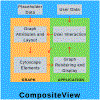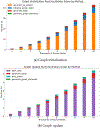CompositeView: A Network-Based Visualization Tool
- PMID: 35847767
- PMCID: PMC9281616
- DOI: 10.3390/bdcc6020066
CompositeView: A Network-Based Visualization Tool
Abstract
Large networks are quintessential to bioinformatics, knowledge graphs, social network analysis, and graph-based learning. CompositeView is a Python-based open-source application that improves interactive complex network visualization and extraction of actionable insight. CompositeView utilizes specifically formatted input data to calculate composite scores and display them using the Cytoscape component of Dash. Composite scores are defined representations of smaller sets of conceptually similar data that, when combined, generate a single score to reduce information overload. Visualized interactive results are user-refined via filtering elements such as node value and edge weight sliders and graph manipulation options (e.g., node color and layout spread). The primary difference between CompositeView and other network visualization tools is its ability to auto-calculate and auto-update composite scores as the user interactively filters or aggregates data. CompositeView was developed to visualize network relevance rankings, but it performs well with non-network data. Three disparate CompositeView use cases are shown: relevance rankings from SemNet 2.0, an open-source knowledge graph relationship ranking software for biomedical literature-based discovery; Human Development Index (HDI) data; and the Framingham cardiovascular study. CompositeView was stress tested to construct reference benchmarks that define breadth and size of data effectively visualized. Finally, CompositeView is compared to Excel, Tableau, Cytoscape, neo4j, NodeXL, and Gephi.
Keywords: CompositeView; HeteSim; SemNet; biomedical knowledge graph; concept relatedness; link prediction; network analysis.
Conflict of interest statement
Conflicts of Interest: The authors declare no conflict of interest. The funders had no role in the design of the study; in the collection, analyses, or interpretation of data; in the writing of the manuscript; or in the decision to publish the results.
Figures















Similar articles
-
SemNet: Using Local Features to Navigate the Biomedical Concept Graph.Front Bioeng Biotechnol. 2019 Jul 3;7:156. doi: 10.3389/fbioe.2019.00156. eCollection 2019. Front Bioeng Biotechnol. 2019. PMID: 31334227 Free PMC article.
-
Optimizations for Computing Relatedness in Biomedical Heterogeneous Information Networks: SemNet 2.0.Big Data Cogn Comput. 2022 Mar;6(1):27. doi: 10.3390/bdcc6010027. Epub 2022 Mar 1. Big Data Cogn Comput. 2022. PMID: 35936510 Free PMC article.
-
Expediting knowledge acquisition by a web framework for Knowledge Graph Exploration and Visualization (KGEV): case studies on COVID-19 and Human Phenotype Ontology.BMC Med Inform Decis Mak. 2022 Jun 2;22(Suppl 2):147. doi: 10.1186/s12911-022-01848-z. BMC Med Inform Decis Mak. 2022. PMID: 35655307 Free PMC article.
-
Linking Cytoscape and the corynebacterial reference database CoryneRegNet.BMC Genomics. 2008 Apr 21;9:184. doi: 10.1186/1471-2164-9-184. BMC Genomics. 2008. PMID: 18426593 Free PMC article.
-
An inductive graph neural network model for compound-protein interaction prediction based on a homogeneous graph.Brief Bioinform. 2022 May 13;23(3):bbac073. doi: 10.1093/bib/bbac073. Brief Bioinform. 2022. PMID: 35275993 Free PMC article. Review.
Cited by
-
Artificial Intelligence-Assisted Comparative Analysis of the Overlapping Molecular Pathophysiology of Alzheimer's Disease, Amyotrophic Lateral Sclerosis, and Frontotemporal Dementia.Int J Mol Sci. 2024 Dec 15;25(24):13450. doi: 10.3390/ijms252413450. Int J Mol Sci. 2024. PMID: 39769215 Free PMC article.
-
Cross-Domain Text Mining to Predict Adverse Events from Tyrosine Kinase Inhibitors for Chronic Myeloid Leukemia.Cancers (Basel). 2022 Sep 26;14(19):4686. doi: 10.3390/cancers14194686. Cancers (Basel). 2022. PMID: 36230609 Free PMC article.
-
Cross-Domain Text Mining of Pathophysiological Processes Associated with Diabetic Kidney Disease.Int J Mol Sci. 2024 Apr 19;25(8):4503. doi: 10.3390/ijms25084503. Int J Mol Sci. 2024. PMID: 38674089 Free PMC article.
References
-
- What Is Data Visualization? Definition, Examples, and Learning Resources. Available online: https://www.tableau.com/learn/articles/data-visualization (accessed on 28 February 2022).
-
- Friendly M A Brief History of Data Visualization. In Handbook of Data Visualization; Springer: Berlin/Heidelberg, Germany, 2008; pp. 15–56.
-
- Ware C Information Visualization: Perception for Design; Elsvier: Amsterdam, The Netherlands, 2012. C2009-0-62432-6.
-
- What Is Tableau. Available online: https://www.tableau.com/why-tableau/what-is-tableau (accessed on 28 February 2022).
-
- Bastian M; Heymann S; Jacomy M Gephi: An open source software for exploring and manipulating networks. In Proceedings of the International AAAI Conference on Web and Social Media, San Jose, CA, USA, 17–20 May 2009; Volume 3, pp. 361–362.
Grants and funding
LinkOut - more resources
Full Text Sources
